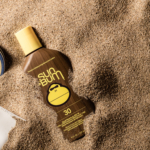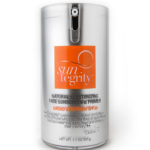size =gallery size =gallery size =gallery
size =gallery size =gallery size =gallery size =gallery size =gallery size =gallery size =gallery size =gallery size =gallery size =gallery size =gallery size =gallery size =gallery
1 of 16 Getty Images / Carol Yepes
Why Go Reef-Safe?
The sunscreen in your beach tote may be damaging coral reefs. While changes in ocean temperatures and acidification caused by climate change are deadly threats to coral, common ingredients in sunscreens like oxybenzone, octinoxate, and butylparaben can harm reefs and contribute to coral bleaching.
From Hawaii’s Hanauma Bay Nature Preserve to the Great Barrier Reef, coral reefs around the world are shrinking and dying at alarming rates. More than 90 percent of the Great Barrier Reef has been bleached to some degree, and half of its coral has died since 2016. Scientists are estimating that more than 90 percent of reefs worldwide will be threatened by 2030, and the United Nations has predicted that all World Heritage coral reefs are likely to be dead by 2100 if drastic measures are not taken.
Fourteen-thousand tons of sunscreen are washed into the ocean each year where it poisons the coral and works its way up the food chain into the fish and seafood we eat. Studies by the Haereticus Environmental Laboratory have found oxybenzone in oysters, crayfish, lobster, blue crab, and even fish caught and served in Hawaii according to Craig Downs, the executive director of HEL.
On May 1, Hawaii banned the sale of sunscreens that contain these chemicals. The ban doesn’t go into effect until January of 2021, but places like Hanauma Bay State Park are already encouraging visitors to use reef-safe sunscreen.
While it’s most important when you are swimming and lounging at the beach, the sunscreen you slather on at the pool or before a hike can make its way into the ocean too. The chemicals in sunscreen wash off in the shower or pool and make their way through the water treatment system and into local waterways and the ocean.
“Sewage is the biggest source of this personal care pollution everywhere,” said Downs. “I don’t just mean Hawaii, but California, Lake Tahoe, Lake Erie, Ohio – all over the world.”
From Hawaii’s Hanauma Bay Nature Preserve to the Great Barrier Reef, coral reefs around the world are shrinking and dying at alarming rates. More than 90 percent of the Great Barrier Reef has been bleached to some degree, and half of its coral has died since 2016. Scientists are estimating that more than 90 percent of reefs worldwide will be threatened by 2030, and the United Nations has predicted that all World Heritage coral reefs are likely to be dead by 2100 if drastic measures are not taken.
Fourteen-thousand tons of sunscreen are washed into the ocean each year where it poisons the coral and works its way up the food chain into the fish and seafood we eat. Studies by the Haereticus Environmental Laboratory have found oxybenzone in oysters, crayfish, lobster, blue crab, and even fish caught and served in Hawaii according to Craig Downs, the executive director of HEL.
On May 1, Hawaii banned the sale of sunscreens that contain these chemicals. The ban doesn’t go into effect until January of 2021, but places like Hanauma Bay State Park are already encouraging visitors to use reef-safe sunscreen.
While it’s most important when you are swimming and lounging at the beach, the sunscreen you slather on at the pool or before a hike can make its way into the ocean too. The chemicals in sunscreen wash off in the shower or pool and make their way through the water treatment system and into local waterways and the ocean.
“Sewage is the biggest source of this personal care pollution everywhere,” said Downs. “I don’t just mean Hawaii, but California, Lake Tahoe, Lake Erie, Ohio – all over the world.”
2 of 16 Getty Images / Jordan Lutes
Our Picks for Reef-Safe Sunscreens
While avoiding excessive sun exposure and protecting your skin with clothing and a hat is best, reef-safe sunscreen can also help prevent skin damage from harmful UV rays without damaging coral and other ocean life. What to look for:
- No nanoparticles
- Free from chemicals like oxybenzone, butylparaben, octinoxate, octocrylene, and PABA
- Non-nano zinc oxide or non-nano titanium dioxide for UVA/UVB (broad spectrum) coverage
- Lotion or balm, not spray. Sprays disperse the sunscreen into the air and environment, are difficult to apply with adequate coverage, and release air pollutants when sprayed.
More Videos From Sunset
How to Pack an Emergency Kit
Be ready for any disaster with a pre-packed emergency kit.
More Videos
0 seconds of 1 minute, 11 secondsVolume 0%
Press shift question mark to access a list of keyboard shortcuts
Keyboard Shortcuts
Shortcuts Open/Close/ or ?
Play/PauseSPACE
Increase Volume↑
Decrease Volume↓
Seek Forward→
Seek Backward←
Captions On/Offc
Fullscreen/Exit Fullscreenf
Mute/Unmutem
Decrease Caption Size-
Increase Caption Size+ or =
Seek %0-9
Copied
Copied
Live
00:00
01:11
01:11
3 of 16 Thomas J. Story
Raw Love Sunscreen
This creamy, solid salve from Maui’s west side uses organic plant-based ingredients. [shopping_cart_button text="Raw Love Sunscreen" price="$25" url="https://rawlovesunscreen.com/product/reef-safe-sunscreen-4/"]
4 of 16 Thomas J. Story
Sun Bum Original SPF 30 Sunscreen Lotion
A favorite sunscreen of surfers feels the most like traditional sunblock. [shopping_cart_button text="Sun Bum Lotion" price="$16" url="https://www.trustthebum.com/collections/sunscreen-plp/products/original-spf-30-sunscreen-lotion"]
5 of 16 Thomas J. Story
Manda Organic SPF 50 Sun Paste
The key ingredient, thanaka, is made from bark that has been a Myanmar cultural staple for centuries. [shopping_cart_button text="Manda Sun Paste" price="$28" url="https://mandanaturals.com/collections/all-products/products/manda-organic-sun-paste-spf-50-40-grams"]
6 of 16 Thomas J. Story
Juice Beauty SPF 30 Sport Sunscreen
Light and non-chalky, with a matte finish, and it doesn’t leave any white residue on your skin. $16; juicebeauty.com. [shopping_cart_button text="Juice Beauty Sunscreen" price="$16" url="https://juicebeauty.com/collections/skincare-shop-by-category-sun-protection-spf/products/spf-30-sport-sunscreen "]
7 of 16 Courtesy of BurnOut
All-Day Activity
- BurnOut Eco Sensitive Sunscreen SPF 35, $18 for 3oz
8 of 16 Courtesy of Thinksport
Family-Friendly
- Thinksport Kids Safe Sunscreen SPF 50+, $13 for 3oz
9 of 16 Courtesy of MyChelle
Nourishing and Hydrating
Summer can be brutal on the skin. Coconut oil and shea butter hydrate and help prevent moisture loss. This zinc oxide sunscreen rubs in like lotion and doesn’t leave you with white streaks or a white tint to your skin so you can comfortably wear it daily.
10 of 16 Courtesy of Suntegrity
Moisturizing Primer
Add SPF to your makeup routine with this natural moisturizing primer. In addition to protecting against both UVA and UVB rays, it also has hyaluronic acid, organic aloe vera, and green tea to soothe and calm the skin for a smooth, non-greasy finish.
11 of 16 Courtesy of UnSun
For Darker Skin Tones
- UnSun Tinted Mineral Sunscreen SPF 30, $29 for 1.7 fl oz
12 of 16 Courtesy of Juice Beauty
Oil-Free Coverage
- Juice Beauty SPF 30 Oil-Free Moisturizer, $30 for 2 fl oz
13 of 16 Courtesy of Raw Elements
Plastic-Free Surf Screen
- Raw Elements Face + Body SPF 30+, $19 for 3 oz tin
14 of 16 Courtesy of Amazon
Drugstore Score
While this sunscreen may not biodegrade as easily as many of the others on this list, it's free from the most damaging chemicals and can be easier to find in a pinch. The water-resistant, oil-free formula has a matte finish that won’t clog pores.
15 of 16 Courtesy of Manda Naturals
Outdoor Lover’s BFF
- Manda Organic Sun Paste SPF 50, $28 for 1.41 oz
16 of 16 Courtesy of All Good
Lip Love
- All Good Lips SPF 20, $3.50

















